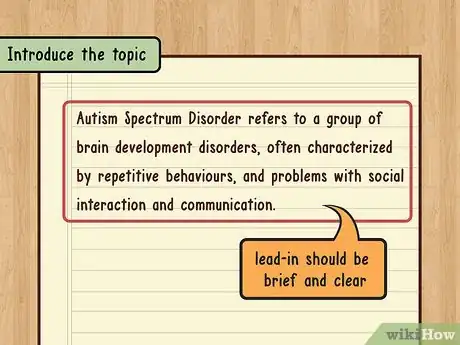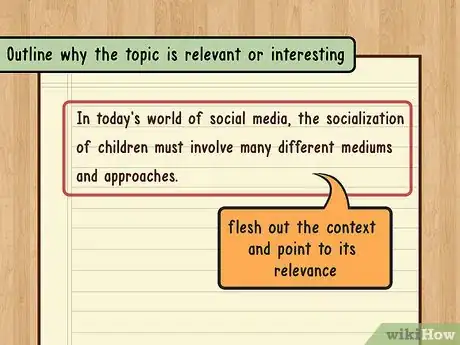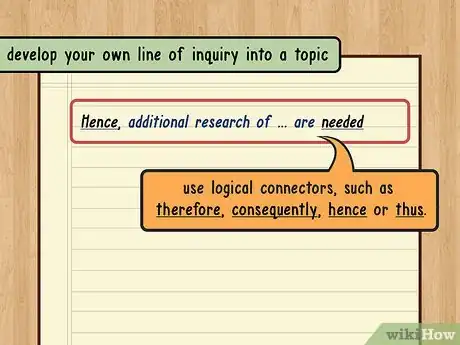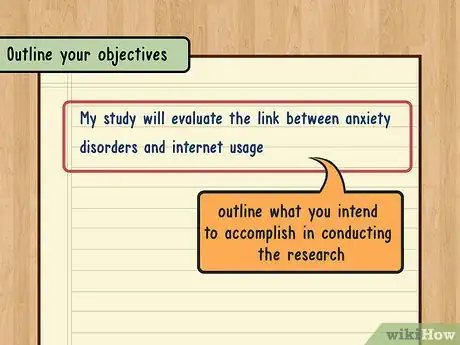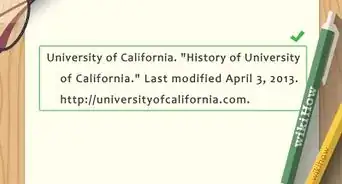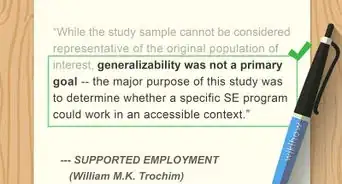This article was co-authored by Christopher Taylor, PhD. Christopher Taylor is an Adjunct Assistant Professor of English at Austin Community College in Texas. He received his PhD in English Literature and Medieval Studies from the University of Texas at Austin in 2014.
This article has been viewed 35,704 times.
In academic writing, the "CARS" model proposed by John Swales is an efficient way to outline your research to the reader. Swales researched the structure of introductions found in academic articles and came up with a process of "moves" that result in a succinct, well-formatted and clear introduction. To follow this model, establish the research territory by introducing the topic, saying why it is relevant, and outlining previous research on it. Next, establish your niche by making a counter-claim, showing a hole in pre-existing research, or added to ongoing research in the field. Finally, summarize your objectives, methodology, and the results of your research.
Steps
Establishing the Research Territory
-
1Introduce the topic. When writing a Swalesian introduction, begin by setting up the field you're writing about in a succinct summary. This first sentence (or sentences) holds a lot of weight as it sets up the focus for the article to follow. Your lead-in should be brief and clear enough for the reader to understand what the article will pertain to.[1]
- Define your field of study by providing necessary background on your topic. What must your reader absolutely know so that they can understand the rest of your article's core concepts?
- For example: "Autism Spectrum Disorder refers to a group of brain development disabilities, often characterized by repetitive behaviour, and struggles with communication and social situations."
-
2Outline why the topic is relevant or interesting. Your introduction should now establish the topic within the realm of real world circumstance or present-day research. This part will flesh out the context of the subject and point to its relevance. In essence, this is where you let your reader know why your own research is relevant, also.[2]
- You could write something like, "In today's world of social media, the socialization of children must involve many different mediums and approaches."
Advertisement -
3Refer to previous research. At this point you may also introduce reviews of previous research undertaken in the field. This will substantiate your lead-in statement and establish your familiarity with relevant scholarly work on the topic. This sentence (or sentences) will connect what has been proposed to who proposed it.[3]
- For instance: "American theorist John Dewey concluded that human beings learn best from a 'hands on' approach to education."
Defining Your Niche
-
1Make a counter-claim. The next step in a Swalesian introduction is to create a niche for your research, which you can establish by making a counter-claim about the subject of your article. To make a counter-claim, opt to introduce an opposing viewpoint, or point out flaws in already-established research in the field. This kind of negative evaluation will clear the way for you to establish your own niche within relevant research.[4]
- For example, your claim might say, "The social impacts of climate change have been studied extensively. However, this research has yet to account for the impact income can play in being willing to participate in movements toward sustainability."
-
2Identify a research gap. Another option for establishing your niche is to demonstrate a lack, or deficiency, of research on the topic. Try to outline previous research and show where this scholarship has missed the niche that you are outlining in your article (e.g. "However, little research has been conducted on..."). Avoid this option if you have referred to other research in your introductory lead-in.
- You can also raise a specific question with regard to established-research in the field (e.g."The question remains, is Freud's theory of psychosexual development relevant in today's social climate?")
-
3Continue developing your own line of inquiry into a topic. If you do not wish to refute or undermine established research on a topic, you can establish your own niche by proposing to build on work that has already been done. To do so, you should establish what has been concluded about this topic and use a connector statement (e.g. "therefore", "so") to connect it to your own work. In essence, you are respecting and continuing a tradition of research within the field.[5]
- For example, you could make a claim like, "Therefore, based on Johnson's findings about learning to read and early childhood development, it is now necessary to consider at what is a child too young to receive the benefits from learning to read?"
Occupying the Niche
-
1Outline your objectives. Identify the purpose of your research to help the reader follow the development of your thesis statement. Clearly outline what you intend to accomplish in conducting the research and what the article will convey to the reader. This should be a definitive statement (e.g. "My study will evaluate the link between anxiety disorders and internet usage").
-
2Explain your methodology. Next, outline the methods you used to reach your results. Explain this succinctly to give the reader a sense of how you reached your conclusion, but avoid going into too much detail at this point (e.g. "I will argue that the use of electronic readers has had an improvement on literacy rates amongst grade school students"). Your full methodology will be fleshed out over the body of the article.
-
3Identify the structure of your writing. It is helpful to detail the organizational flow of your work in the article before the reader reaches the more substantive part of it. Doing this in the introduction will give them a sense of how information will be sequenced and presented as they read further. Outlining the structural breakdown of your work is ideal (for example: "This paper will be divided into four main sections: Hypothesis, Initial Research,Comparative Studies, and Final Results").[6]
-
4Evaluate your findings. To conclude your introduction, offer a quick summary of the results of your study. You can also add how these findings contribute to the pre-existing body of research on the topic. In addition, you might consider noting what future research should be done given your findings.[7]
- E.g. "These results show that there is an observable correlation between social media activity and test scores in high school students. The results support popular scholarly theories that traditional high school curriculum does not engage today's generation of students. Further research could examine the links between social media and educational reform."
Expert Q&A
-
QuestionHow do you write an introduction to a research paper?
 Christopher Taylor, PhDChristopher Taylor is an Adjunct Assistant Professor of English at Austin Community College in Texas. He received his PhD in English Literature and Medieval Studies from the University of Texas at Austin in 2014.
Christopher Taylor, PhDChristopher Taylor is an Adjunct Assistant Professor of English at Austin Community College in Texas. He received his PhD in English Literature and Medieval Studies from the University of Texas at Austin in 2014.
English Professor The CARS method, described in this article, is a very effective method for writing research paper introductions.
The CARS method, described in this article, is a very effective method for writing research paper introductions. -
QuestionHow do you write a good introduction?
 Christopher Taylor, PhDChristopher Taylor is an Adjunct Assistant Professor of English at Austin Community College in Texas. He received his PhD in English Literature and Medieval Studies from the University of Texas at Austin in 2014.
Christopher Taylor, PhDChristopher Taylor is an Adjunct Assistant Professor of English at Austin Community College in Texas. He received his PhD in English Literature and Medieval Studies from the University of Texas at Austin in 2014.
English Professor This article outlines the moves to make for writing an argumenatitive, research-based essay. Other forms of writing might require different styles of introduction, but the important part is to establish the topic and thesis of your essay.
This article outlines the moves to make for writing an argumenatitive, research-based essay. Other forms of writing might require different styles of introduction, but the important part is to establish the topic and thesis of your essay.
References
- ↑ http://justwriteonline.typepad.com/distributed_intelligence/2013/09/writing-essays-introductions.html
- ↑ http://ac.els-cdn.com/S1877042812013201/1-s2.0-S1877042812013201-main.pdf?_tid=9937c570-b033-11e6-a850-00000aab0f02&acdnat=1479764814_89fab055882cdc6851bd52667590c618
- ↑ http://www.cs.tut.fi/kurssit/SGN-16006/academic_writing/cars_model_handout.pdf
- ↑ http://www.cs.tut.fi/kurssit/SGN-16006/academic_writing/cars_model_handout.pdf
- ↑ http://www.cs.tut.fi/kurssit/SGN-16006/academic_writing/cars_model_handout.pdf
- ↑ http://www.cs.tut.fi/kurssit/SGN-16006/academic_writing/cars_model_handout.pdf
- ↑ http://www.cs.tut.fi/kurssit/SGN-16006/academic_writing/cars_model_handout.pdf
